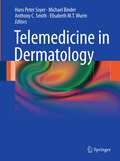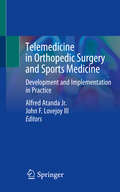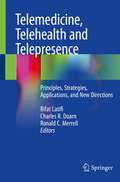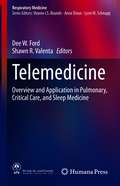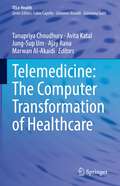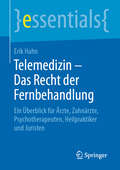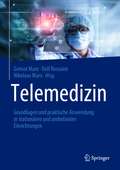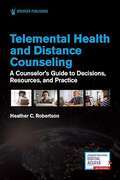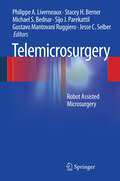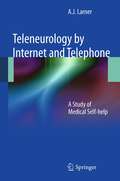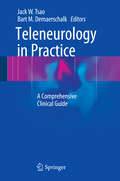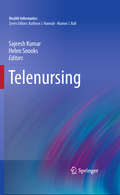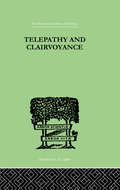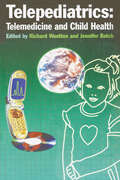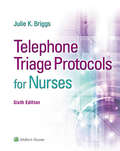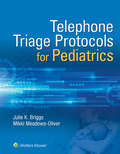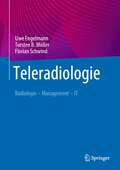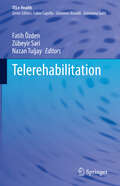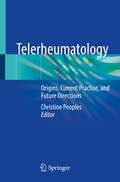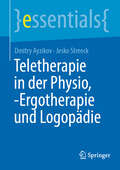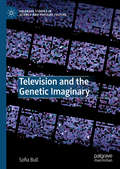- Table View
- List View
Telemedicine in Dermatology
by Michael Binder Elisabeth M.T. Wurm Hans Peter Soyer Anthony C. SmithWritten by leading teledermatologists and telemedicine experts, this hands-on guide addresses the practical needs of the many emerging teledermatology services worldwide. It covers the medical and technical prerequisites for such services as well as the photographic imaging essentials. It also illustrates the performance of teledermatology by means of clinical examples, discusses teledermatology in underdeveloped countries, and presents specialized methods of teledermatology. The impact of telemedicine on the doctor-patient relationship is explored, and the advantages that accrue from improving access to expert knowledge are explained. In addition, quality assurance, legal assumptions, economic aspects, and the future horizons of such health care services are all considered. A comprehensive appendix provides information on training opportunities, sample protocols, consent forms, information sheets, references, and relevant web links.
Telemedicine in Orthopedic Surgery and Sports Medicine: Development and Implementation in Practice
by Alfred Atanda John F. LovejoyAs the healthcare landscape evolves towards value-based treatment models, healthcare providers will be forced to find ways to deliver healthcare in a cost-effective, resource mindful way that provides good care, all the while maintaining appropriate patient satisfaction. Telemedicine offers a way to achieve this goal, in both rural and urban settings and with a varied and diverse patient population - not to mention during global health emergencies, where in-person visits and consultations are not ideal. This book will serve as an introduction to telemedicine and digital health for the orthopedic and sports medicine provider. It will provide a general overview of telemedicine as well as specific suggestions and recommendations: where and how to get started, how to implement a telemedicine program, how to do research in telemedicine, and how to develop clinical guidelines and best practices for work in telemedicine. Specific chapters cover important nuts-and-bolts topics like regulation and licensing, billing and coding, and ethics and etiquette. Suggestions and considerations for provider-to-provider, direct-to-consumer, and school-based telemedicine service are likewise presented. Finally, insights into global telemedicine implementation and research are detailed. While describing specific applications to orthopedic and sports medicine practices, Telemedicine in Orthopedic Surgery and Sports Medicine will cater to any clinician – from the individual solo practitioner to the C-suite level executive – who has a vision for implementation of telemedicine across an entire health system.
Telemedicine, Telehealth and Telepresence: Principles, Strategies, Applications, and New Directions
by Rifat Latifi Charles R. Doarn Ronald C. MerrellTelemedicine and telehealth have consistently been shown to be effective for remote areas or limited-resource locations, regular medical and surgical practice, primary care, second opinion, extreme conditions, major crises, and disaster management. The aim of this book is to bring all aspects of telemedicine and e-health to the reader, in a simple, make-sense approach, in one tome. The book is structured in four parts with 29 chapters written by the best experts in the field from around the world, including clinicians, scientists, and administrators of telemedicine programs. Part I deals with basic principles of telemedicine and telepresence. Historical journeys of telemedicine and strategies, building sustainable telemedicine and telehealth programs in the United States and in the Balkans, as well as incorporation of telemedicine in the current ongoing pandemic COVID-19 are well described and are must read. Current technological developments, rules and regulations, legal and business aspects and consent are also addressed. Part II describes strategies for building sustainable telemedicine and telehealth programs. Telehealth patient portals and public-private partnership modes of technology, as well the role of international telemedicine and how to make it work, are valuable chapters of great significance. Part III describes outcomes-based evidence clinical applications of telemedicine in trauma, burns, intensive care, pediatric care, psychiatry, and stroke. Finally, one important chapter for the readers is the telemedicine for prison and jail population. The final part, Part IV depicts surgical telementoring and teleproctoring, a chapter written by 18 various surgical experts, a true gem for the readers. The book ends with promises and hurdles of telemedicine in austere conditions. Telemedicine, Telehealth and Telepresence serves as a valuable resource that focuses on providing patients care from a distance using store and forward technology to live actual performance of operations at a distance.
Telemedicine: A Guide to Assessing Telecommunications in Health Care
by Committee on Evaluating Clinical Applications of TelemedicineTelemedicine--the use of information and telecommunications technologies to provide and support health care when distance separates the participants--is receiving increasing attention not only in remote areas where health care access is troublesome but also in urban and suburban locations.Yet the benefits and costs of this blend of medicine and digital technologies must be better demonstrated before today's cautious decisionmakers invest significant funds in its development.Telemedicine presents a framework for evaluating patient care applications of telemedicine. The book identifies managerial, technical, policy, legal, and human factors that must be taken into account in evaluating a telemedicine program. The committee reviews previous efforts to establish evaluation frameworks and reports on results from several completed studies of image transmission, consulting from remote locations, and other telemedicine programs.The committee also examines basic elements of an evaluation and considers relevant issues of quality, accessibility, and cost of health care.Telemedicine will be of immediate interest to anyone with interest in the clinical application of telemedicine.
Telemedicine: Overview and Application in Pulmonary, Critical Care, and Sleep Medicine (Respiratory Medicine)
by Dee W. Ford Shawn R. ValentaThis book provides an overview of key issues with regards to implementing telemedicine services as well as an in depth overview of telemedicine in pulmonary, critical care, and sleep medicine. Topics range from specific practices to program development. Telemedicine has experienced explosive growth in recent years and yet, implementing telemedicine solutions is complex with substantial regulatory, legal, financial, logistical, and intra-organization/intra-personal barriers that must be overcome. This book provides the necessary information and guidance to address those complex issues. This book is broadly divided into two parts 1) a primer on requisite steps before embarking on telemedicine service development and 2) specific applications and examples where telemedicine is successfully utilized to improve quality of care in pulmonary, critical care, and sleep medicine. The first part includes coverage of telemedicine and finance, regulatory and legal issues, and program development. The second part delves into specifics with information on ambulatory telemedicine programs, inpatient consultations, and tele-ICU programs. All chapters are written by interprofessional authors that are leaders in the field of telemedicine with extensive knowledge of diverse telemedicine programs and robust real-world experience on the topic. This is an ideal guide for telehealth program managers, and pulmonary, critical care, and sleep medicine professionals interested in improving their telehealth practice.
Telemedicine: The Computer Transformation of Healthcare (TELe-Health)
by Jung-Sup Um Tanupriya Choudhury Avita Katal Ajay Rana Marwan Al-AkaidiThis book provides an overview of the innovative concepts, methodologies and frameworks that will increase the feasibility of the existing telemedicine system. With the arrival of advanced technologies, telehealth has become a new subject, requiring a different understanding of IT devices and of their use, to fulfill health needs. Different topics are discussed - from the basics of TeleMedicine, to help readers understand the technology from ground up, to details about the infrastructure and communication technologies to offer deeper insights into the technology. The use of IoT and cloud services along with the use of blockchain technology in TeleMedicine are also discussed. Detailed information about the use of machine learning and computer vision techniques for the proper transmission of medical data - keeping in mind the bandwidth of the network - are provided. The book will be a readily accessible source of information for professionals working in the area of information technology as well as for the all those involved in the healthcare environment.
Telemedizin – Das Recht der Fernbehandlung: Ein Überblick für Ärzte, Zahnärzte, Psychotherapeuten, Heilpraktiker und Juristen (essentials)
by Erik HahnDieses essential zeigt praxisnah die rechtlichen Anforderungen an eine (ausschließliche) Fernbehandlung aus deutscher Perspektive. Die berufs-, vertrags-, vergütungs-, werbe- und arzneimittelrechtlichen Grundlagen sowie die jeweiligen Besonderheiten für Ärzte, Zahnärzte, Psychotherapeuten und Heilpraktiker werden umfassend erläutert. Es bietet zudem einen Überblick über die europarechtlichen Vorgaben und deren Umsetzung im nationalen Recht. Außerdem wird das unterschiedlich ausgestaltete Fernbehandlungsrecht der einzelnen Heilberufskammern dargestellt.
Telemedizin: Grundlagen und praktische Anwendung in stationären und ambulanten Einrichtungen
by Rolf Rossaint Gernot Marx Nikolaus MarxDas vorliegende Buch gibt einen umfassenden Überblick über den aktuellen Stand und die Entwicklungen im Bereich der Telemedizin in Deutschland. Das Herausgeberteam aus einem der führenden Telemedizinzentren Deutschlands und ein interdisziplinäres Autorenteam liefern wesentliche Grundlagen sowie zahlreiche Anwendungsbeispiele aus dem stationären und ambulanten Bereich. Zudem werden Chancen und Risiken der Telemedizin erörtert, so dass der Leser gut für die Zukunft in Klinik oder Praxis gerüstet ist. Ein Grundlagen- und Nachschlagewerk für alle Ärzte, die sich für digitale Zukunft im Gesundheitswesen wappnen und ihre Patienten optimal versorgen möchten.
Telemental Health and Distance Counseling: A Counselor's Guide to Decisions, Resources, and Practice
by Heather C. RobertsonThis timely text provides foundational knowledge and skills pertaining to ethical and evidence-based practice for mental health providers engaging in or considering using distance modalities to treat clients. Targeting day-to-day application, the book explains the core functions of Telemental Health counseling (TMH) and its use across a broad spectrum of mental health modalities and settings. Using the framework of the ACA divisions, ASCA, and CACREP core areas to examine TMH, the text provides instructions to develop skills that readers can apply directly to their own counseling interactions. Providing a wealth of information based on empirical and impartial views, the book helps readers examine the benefits and risks of distance counseling in various settings. It encompasses the history of TMH, ethical codes, legal guidelines, and recent research. <P><P> Case studies and opportunities for self-reflection enable readers to envision distance counseling in real-world contexts, ask critical questions, and form conclusions about its utility in their practice. Of particular value is the "Voices from the Field" feature, where practitioners from different settings describe using distance counseling. The "Challenges and Opportunities" features discuss the pros and cons of telemental health practice. The book is written through the lens of professional counseling which makes it an ideal companion to Counselor Education program courses in Counseling Skills, Pre-Practicum, Advanced Theory, or elective coursework pertaining to distance counseling and telemental health.
Telemicrosurgery
by Sijo J. Parekattil Stacey H. Berner Gustavo Mantovani Ruggiero Philippe A. Liverneaux Jesse C. Selber Michael S. BednarThe purpose of this book is to define the basis of telemicrosurgery, a new discipline at the border of robotics and microsurgery. After the history of robotics and microsurgery, the robots and their instrumentation will be described. The chapters will explain the training in telemicrosurgery and then propose some experimental paradigms. The first clinical applications for various specialties will be explored. In closing, potential future applications will be discussed.
Teleneurology by Internet and Telephone
by A. J. LarnerMedical information is now widely available on the Internet and through telephone helplines such as NHS Direct and the focus on patient self care is likely to increase. Clinicians in all specialties will often encounter patients who have made self-directed searches for medical information prior to the clinical encounter. Teleneurology by Internet and Telephone is a study of patient information-seeking behaviour in neurology patients prior to referral from primary to secondary care. The book analyses frequency of Internet access and use, and of telephone helpline awareness and use. It also explores use of these modalities over time, use according to patient gender and age and by gender and age over time. Teleneurology by Internet and Telephone is an accessible overview of the utility of these modalities of health information provision and will be of interest not only to neurologists and clinicians in other specialities but also to public health researchers, sociologists and political scientists with an interest in questions of health care provision.
Teleneurology in Practice
by Jack W. Tsao Bart M. DemaerschalkThis title will provide an up-to-date review of the emerging practice of neurology telemedicine. Increasingly, neurology, like other disciplines of medicine, is implementing the technological advances and discoveries of the science of healthcare delivery to improve not only access and efficiency but outcomes and cost as well. For patients in remote and underserved areas, having a neurological condition means lengthy and costly travel to obtain specialist evaluation. Telemedicine has the ability to deliver such care to a patient's local community. Neurology telemedicine for acute stroke has already demonstrated clinical efficacy and cost effectiveness by raising the numbers of thrombolysis-eligible patients who can be treated in a timely fashion. More than 85% of leading US neurology departments currently use or plan to implement telemedicine within the next year. The US military has a limited number of neurologists - a store-and-forward consultation system has enabled military neurologists to deliver far-forward battlefield care for service members deployed overseas. The chapters in this book will review the use of telemedicine for the evaluation and treatment of patients with many common neurological conditions and will provide a practical guide for neurologists seeking to incorporate telemedicine into their daily practices.
Telenursing
by Helen Snooks Sajeesh KumarWritten by experts from around the globe (USA, Europe, Australia and Asia) this book explains technical issues, digital information processing and collective experiences from practitioners in different parts of the world practicing a wide range of telenursing applications including telenursing research by professionals in the field. This book lays the foundations for the globalisation of telenursing procedures, making it possible to know that a nursing service could perform on a patient anywhere in the world.
Telepathy and Clairvoyance (International Library Of Psychology Ser.)
by Tischner, RudolfFirst published in 1999. Routledge is an imprint of Taylor & Francis, an informa company.
Telepediatrics: Telemedicine and Child Health
by Amanda OakleyRecommended to all health professionals currently working or planning to set up services in paediatrics and telemedicine. This book is written by an international team of contributors who are working with paediatric telemedicine services. It covers a broad spectrum of topics:Specialist services: including Fetal medicine, Child psychiatry , Diabetes , Asthma, Burns, Paediatric surgery clinics, Sexual abuse, Tele-ophthalmology, Teleradiology and image transfer, Tele-ENTPrimary and community services: including Telemedicine and under-served communities (US and developing countries), Palliative care, Rehabilitation, Telephone help lines for parentsEducation services including: Education of doctors - Grand Rounds in Queensland, Australia, Educational videoconferences for parents in the Bronx, and websites for parents and children
Telephone Triage Protocols for Nurses
by Julie K. BriggsPerforming triage requires the ability to make quick, evidence-based decisions based on limited information. Nurses are often required to preform triage either over the phone, in urgent care settings, in the emergency department, and even in office settings. This reference provides over 200 triage protocols for evaluating a person’s symptoms. Each symptom entry lists pertinent questions grouped by urgency level and advises the clinician when and where the patient should be referred. This book is a need to have, comprehensive, user-friendly resource for every nurse who performs triage.
Telephone Triage for Obstetrics & Gynecology
by Vicki Long Patricia McMullenProvide top-level obstetrics and gynecology telephone triage that is safe, efficient, and effective, with Telephone Triage for Obstetrics & Gynecology, 3rd Edition. This at-your-fingertips guide offers a wide range of current, evidence-based protocols, backed by proven patient-questioning techniques, quick-reference charts, and real-life patient scenarios. Adaptable to private practice, hospital, clinic, or call center, this invaluable guide will help ensure that your telephone triage standards stay high, while your practice serves individual patient situations with empathy and accuracy, right from the start. Be expertly guided through the telephone triage rigors of data-gathering, protocols, and patient education, with these vital features: NEW chapter on incorporating internet research into advice on specific protoc NEW and expanded protocols that offer updated content on preconceptual screening, infectious disease impacts on pregnancy, infertility management, and emergency contraception Quick-reference sections that arrange protocols alphabetically for fast locating Easy-to-follow, data-gathering, flowchart format that helps you quickly determine the nature and urgency of the caller’s problem, and choose the appropriate intervention Easy-to-explain patient-education sections after each protocol Basic Triage Assessment Forms that address specific problems and require vital patient data Guidance on developing “telephone charisma” and the power of sympathetic listening Effective patient questioning techniques—pertinent questions to ask, types of questions, time management, getting clarification Real-life call scenarios that point out problems with not listening fully to the patient, skipping relevant questions, or exerting judgments Covers telephone triage basics, including logistical and legal considerations, assessments, telephone communication basics and challenges, and more Offers obstetric protocols, including overviews of preconceptual and infertility, early management of unintended pregnancy, fetal prenatal screening, early pregnancy evaluation and surveillance, and more Offers gynecologic protocols, including overviews of abnormal bleeding and spotting, amenorrhea, barrier contraceptives, breast complaints, emergency contraception, injectable contraceptives, intrauterine contraception, menopausal concerns, and more Vital guidance for all gynecologic nurses, obstetric nurses, certified nurse midwives, OB/GYN nurse practitioners, all triage nurses, and health professionals at call centers
Telephone Triage for Pediatrics
by Julie Briggs Mikki Meadows-OliverHandle questions about pediatric care with confident accuracy: Telephone Triage Protocols for Pediatrics is the quick-access guide to providing fast, efficient phone assessments and accurate care recommendations. This comprehensive, on-the-spot resource lists a broad range of symptoms alphabetically. A flow chart format provides the crucial Yes or No questions to ask, with each answer moving quickly to optimal recommendations or instructions. A vital resource for all nurses, this is irreplaceable to those in pediatric or family practice. Tap into top-level guidance for fast, efficient assessments … Step-by-step guidance for making accurate assessments—170 proven protocols addressing a wide range of symptoms, disorders, and medical emergencies, for newborn to age 18 Sorts life-threatening problems from those not requiring physician or emergency care—callers are directed to make an appointment, seek emergency care, or follow home care instructions Increases consistency of advice and documentation Supports nurses of all knowledge and experience levels Color tabs for each section enable quick access Symptoms alpha-organized and grouped by level of urgency, addressing injuries, trauma, pain, swelling, and other symptoms for: Head, eyes, ears, nose, throat, mouth, back, neck, arm, and leg Body system problems – chest/cardiovascular, respiratory GI, genital/obstetrics and gynecological problems, urination, and skin problems Chronic and infectious diseases Behavioral problems Infant-specific problems Sections under every symptom include: Key Questions to ask the caller Other Protocols to Consider Reminders – for proper documentation Assessment – symptoms and conditions that determine urgency Actioncolumn – Following Yes or No answers to assessment questions, with emergency actions appearing first Immediate actions – proven protocols and/or referrals to emergency, physician, or at-home care Home Care Instructions – before emergency care, before appointment, or at-home care Emergency Instructions – in-the-moment first aid Report the Following Problems – what caller should tell their physician or emergency department Seek Emergency Care Immediately – if certain symptoms occur
Teleradiologie: Radiologie – Management – IT
by Torsten B. Möller Uwe Engelmann Florian SchwindTeleradiologische Befundung wird immer wichtiger für Kliniken, die sich nachts und Feiertags keinen Radiologen leisten können oder wollen. Mit der immer populäreren Telemedizin ist auch die Teleradiologie seit Jahren immer mehr gewachsen.Ziel des Buches ist es, umfassend über das teleradiologische Arbeiten, die Möglichkeiten, Arbeitsabläufe, Infrastruktur und Anwendungsbereiche zu informieren. Dabei wird sowohl die Anwenderseite (der radiologische Arzt als Befunder) als auch die Auftraggeber-Seite (die Kliniken) beleuchtet, die hier eng verzahnt interagieren müssen. Inhalte:Das Buch informiert den Leser umfassend über die folgenden Aspekten der TeleradiologieÄrztliche AspekteSicht des Krankenhaus-Managements,gesetzliche Vorgaben (Strahlenschutzgesetz und -verordnung),DIN-Normen,Arbeitsabläufe,Genehmigungsprozess,Qualitätsaspekte,Integration in die IT-Landschaft der Beteiligten,Kommunikationsstandards in der Medizin/Radiologie,Beispiele realisierter Teleradiologie-Netzwerke,Datenschutz undRechtsfragen .
Telerehabilitation
by Sajeesh Kumar Ellen R. CohnWritten by experts from around the globe, this book presents explains technical issues and clinical applications. It includes collective experiences from rehabilitation service providers in different parts of the world practicing a wide range of telerehabilitation applications. This book lays the foundations for the globalization of telerehabilitation procedures, making it possible for rehabilitation service to be delivered anywhere in the world.
Telerehabilitation (TELe-Health)
by Fatih Özden Zübeyir Sari Nazan TuğayTelerehabilitation is becoming one of the most popular health service methods due to the recent advancements in information technology. The aim of this book is to present comprehensive telerehabilitation-based evaluation protocols and treatment modalities, offering evidence-based insights into their efficacy. Within the volume, various rehabilitation departments, including orthopedic, neurological, cardiopulmonary, geriatric, and pediatric rehabilitation, are explored in terms of telerehabilitation applications, practices, and assessment tools. The effectiveness of telerehabilitation methods, which are frequently used in clinical practice, is addressed also in terms of efficiency, cost-effectiveness, and ethics. In addition, international guidelines are pointed out comprehensively. This book will appeal not only to Physiotherapists and PM&R physicians but also to a broader audience of specialists interested in the field of telerehabilitation.
Telerheumatology: Origins, Current Practice, and Future Directions
by Christine PeoplesThis book details the practice of telerheumatology. Telemedicine is defined as the delivery of healthcare and the exchange of healthcare information across distances. Following, telerheumatology is the delivery of rheumatology care through telemedicine. There exists an increasing demand from patients, caregivers, and healthcare systems for access to academic specialists through telemedicine. This has been the case for the past several years and the demand has only increased with the ongoing COVID-19 pandemic. There is currently a lack of rheumatologists in rural areas and that is expected to spread to a general lack by 2025. Telerheumatology offers an excellent and timely solution to fill these gaps and provide care.Telerheumatology care has been shown to be feasible and quite effective. The current COVID-19 pandemic has thrust the concept of telemedicine into the spotlight. However, not all telerheumatology care is the same and there exists many nuances and differences when examining telerheumatology care across the United States and the world. After comprehensively reviewing the origins of telerheumatology, this work defines in detail the current practice of telerheumatology, along with the specific impact of the COVID-19 pandemic and all applications of telerheumatology. Expert authors also provide a detailed roadmap for providers to initiate, sustain, and grow a telerheumatology program. The book concludes by covering future directions of telerheumatology, including areas for expansion, improvement, and innovation.After reading this work, the editor and all the contributing authors hope that it will inspire, provoke thought and discussion, and lead to increased adaptation of providing telerheumatology care by rheumatologists and rheumatology providers.
Teletherapie in der Physio, -Ergotherapie und Logopädie (essentials)
by Jesko Streeck Dmitry AyzikovDas essential bietet einen Leitfaden für Physiotherapeut*innen, Ergotherapeut*innen und Logopäd*innen, um mit Hilfe der Teletherapie eine qualitativ hochwertige Versorgung ermöglichen zu können. Erfahren Sie alles über die Vorteile und die praktische Umsetzung einer Behandlung auf Distanz. Mit klar strukturierten Anleitungen und praxisnahen Beispielen können Sie teletherapeutische Interventionen mühelos umsetzen. Wertvolle Tipps und konkrete Fallbeispiele machen dieses Buch zu einem unverzichtbaren Begleiter. Zudem werden theoretische Grundlagen verständlich erklärt, um Ihr Wissen über die Vorteile der Teletherapie zu vertiefen. Aus dem Inhalt: Neugestaltung der Therapie durch Telemedizin, Entscheidungsfindung zur Eignung eines Patienten für Teletherapie, was ist Teletherapie und welche Faktoren beeinflussen eine Behandlung?, Die Rolle der Therapeut*in im Genesungsprozess der Patient*innen, Onlinediagnostik und Differentialdiagnostik, Tipps und Tricks für die Gestaltung einer Teletherapeutischer Sitzung und ein Praxisbeispiel einer Behandlung auf Distanz.
Television and the Genetic Imaginary (Palgrave Studies in Science and Popular Culture)
by Sofia BullThis book examines the complex ways in which television articulates ideas about DNA in the early 21st century. Considering television’s distinct aesthetic and narrative forms, as well as its specific cultural roles, it identifies TV as a key site for the genetic imaginary. The book addresses the key themes of complexity and kinship, which function as nodes around which older essentialist notions about the human genome clash with newly emergent post-genomic sensibilities. Analysing a wide range of US and UK programmes, from science documentaries, science fiction serials and crime procedurals, to family history programmes, sitcoms and reality shows, Television and the Genetic Imaginary illustrates the extent to which molecular frameworks of understanding now permeate popular culture.
Television in the Nursing Home: A Case Study of the Media Consumption Routines and Strategies of Nursing Home Residents
by Wendy J HajjarTelevision in the Nursing Home: A Case Study of the Media Consumption Routines and Strategies of Nursing Home Residents is a three-stage ethnographic study of media use by the elderly in long-term care facilities. This research concludes that watching television is the most prevalent and pervasive activity for patients. Activity directors can now learn how television and media can offer diversion, enhancement of personality, awareness, and sociability to their patients and offers suggestions on roommate coordination, selection of appropriate media, and communication resources. Containing the latest knowledge involving communication and gerontology, Television in the Nursing Home will help you offer programs that will meet the demands of an expanding elderly population.Developed as a perspective for examining patterns of social interaction, Television in the Nursing Home gives suggestions on how you can use the media to create new activities for patients, maximizing the television as a resource for the elderly. You will gain valuable insight on: proof to dispel the myth that television in long-term patient care causes withdrawal and depression a breakthrough in the treatment of media and aging, enhancing media-based activities and the use and purchase of electronic equipment for care facilities studies on how and why television is the most accessible medium of communication information for the development of new media designed specifically for use by the elderly creation of media-centered activities that recognize the potential for therapeutic use of communication technologies in the nursing homeThe research presented in Television in the Nursing Home establishes the fact that television consumption, once thought to be problematic, should be seen as desirable and necessary. This important book also proves how television is a resource that provides comfort, self-expression, and sociality. This first-ever study will convince you that television and media use in long-term care is beneficial and essential to the wellness of your patients.
